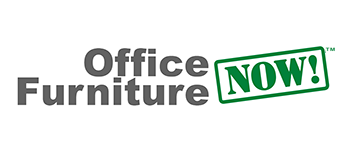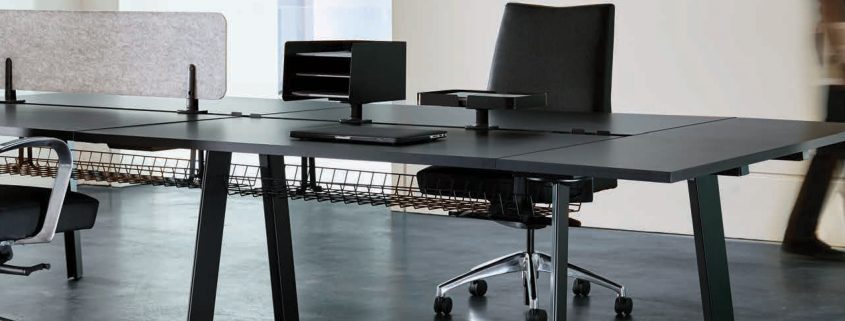Rethinking Office Desks
Rethinking how your team uses office desks and seeking alternatives that enhance a more modern workflow is a vital part of today’s office design. As more employees reconfigure their work days to include telecommuting, remote-based work, and collaborative meetings, the number of dedicated office desks is diminishing. It might be worthwhile to ask your employees if their personal workspace meets their productivity and comfort levels.
Evaluating the functionality of your office design with regularity will keep you in touch with the changing work styles of your team. Not all office desks are created equal. Adjustable height desks, treadmill workstations, data-integrated personal tables, and “wireless” desks are swiftly dominating modern commercial workspaces for one simple reason:
They adapt to the employee’s needs, they don’t require the employee to adapt to them.
Optimize Your Office Desks
Office desks give the environment a certain personality, which is important if clients frequently visit the office. Your workstyle is on display. A modern aesthetic gives the impression that you are a forward-thinking collaborator. Open plan design is synonymous with open collaboration and that mindset is an integral part of client and staff retention.
It’s easy to take office desks for granted, but they play a critical role in determining how productive an employee is. Providing the right desk for the task is the most efficient course of action. During renovation or initial set-up of an office, you need to consider office desks that are functional to the role of each employee.
For instance, if a particular employee will need to use more than one monitor in order to work, the desk area should be set up to allow adequate placement of multiple monitors and still allow free space for other tasks. Figure in adaptability. Office desks should to be ergonomic to reduce strain and have height-adjustability options. Make the desk set up adapt to the employee’s needs, rather than the other way round.
Provide a Variety of Seating Options
Apart from desks, seating options should be ergonomic and designed to meet a variety of tasks. For informal collaboration, you could invest in small seating groups or a semi-circular sofa which allows employees working on a single project to communicate with each other outside the boundaries of a desk. The collaboration process becomes more casual and a lot more effective and will result in faster turnaround times for projects.
Employees that need to work alone, rather than in a group, for specific projects would beneifit from dedicated areas where they can tune out and focus. Offering smaller seating hubs such as enclaves with padded benches and privacy partitions would be an ideal soultion. Remember to consult an experienced space planner to ensure that the desks and other seating options are installed correctly for longevity and maximum comfort.
Think Beyond the Desk
Including huddle spaces that provide alternative settings with technology support can solve more than just collaboration issues. An important element of physical and creative well-being is movement. Our bodies were not designed to sit in a 90-degree posture all day. The physical and psychological benefits of movement are well researched and documented.
An optimal workplace has a mix of spaces and postures that breaks the bond between the user and the desk. Create work areas that allow for standing as well as sitting. Café-height tables for lunch or coffee breaks, traditional workstations, and small sofa groups for meetings are excellent options. Transform awkward corners into huddle spaces with standing tables to provide a break in routine and encourage impromtu collaboration, making your workplace about people solving problems together.
Make Your Office an Extension of Your Culture & Brand
When you are designing your office space, consider what you want to convey about your business’s personality and culture. It’s important to create a culture of inclusion that gives your staff a feeling of belonging, and a sense of working together for a common goal. Especially if you have remote workers that float in and out of your office. Providing touchdown spaces for them imbibes an all inclusive culture that builds trust and creates bonds. It inspires innovation and creativity and sets the bar for your bottomline. Culture creates a certain vibe in an office space that is palpable when you enter.
Rethinking the way your team works and utilizes their office desk space is the catalyst for collaboration in your office design and space planning. The modern workflow is much more agile than the tradtional desks of a decade ago. Building multitasking into your design plan creates a culture of inclusion for clients, telecommuters, remote workers and in-house collaborators alike.
 MEET ERIKA BARNES: Erika brings a lengthy retail management career to her furniture sales acumen. Her creative mind and excellent customer service will be a strong asset in partnering with you to create the perfect office desk environment for your collaborative office space. Connect with her via email ebarnes@officefurniturenow.com or by calling 888-910-3769 x131. For more inspiration visit us on Facebook, Pinterest, and Twitter!
MEET ERIKA BARNES: Erika brings a lengthy retail management career to her furniture sales acumen. Her creative mind and excellent customer service will be a strong asset in partnering with you to create the perfect office desk environment for your collaborative office space. Connect with her via email ebarnes@officefurniturenow.com or by calling 888-910-3769 x131. For more inspiration visit us on Facebook, Pinterest, and Twitter!



